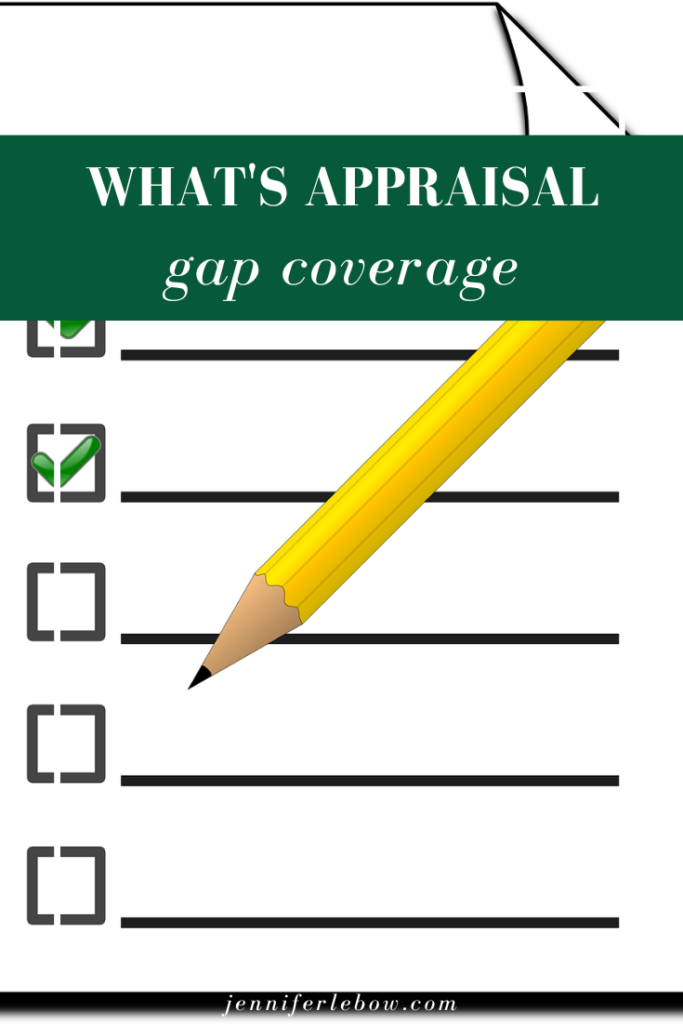
What is an appraisal gap?
To understand what appraisal gap coverage is and how and why it’s used, you need to know what an appraisal gap is. An appraisal gap is the difference between what a buyer has agreed, through a contract, to pay for a house and the amount of the lender’s appraisal. How does the appraiser come up with a value?
How is appraisal value determined?
Appraisers use comparable sales, giving more weight to similar properties that are nearby and have sold most recently. They also look at properties currently available on the market and those that are under contract or pending settlement. An appraisal is a complex analysis of many characteristics, some of which are objective and have specific dollar amounts ascribed to them (like a garage or air conditioning or an additional full bathroom) while others are more subjective (like better condition or a less appealing view). The point is that the appraised value can differ from the amount a buyer and seller have agreed upon.
What if appraisal value and price don’t match?
What happens in this situation? Well, with no changes made to the standard language of an agreement of sale (at least in PA, where I work), the buyer reserves the right to terminate the transaction and receive all deposit monies back if the appraisal comes in below the purchase price. It can be a dollar below, $100,000 below–it doesn’t matter. The buyer is protected. The reason the contract is designed this way? Because the lender agrees to lend a percentage (often 80%) of the “value” but that is appraised value. That means, in the event of a low appraisal, the buyer would have to come up with extra cash to make up the difference. So the pre-written contract allows the buyer to terminate if the appraisal comes in below the purchase price.
Here’s an example:
A property goes under contract for $700,000. The buyer is getting 80% from the lender. That means the buyer is expecting the lender to provide $560,000 and to contribute $140,000 of his own cash toward the purchase price. However, if it appraises and $675,000, the bank’s 80% is now $540,000. So now, if the appraisal contingency that is built in to the contract is waived, in order to honor the contract, the buyer would have to find an additional $20,000.
How the seller views the appraisal
Now that you have a clear picture of how the appraisal works and how the agreement of sale allows a buyer to terminate with no penalty in the event of a low appraisal, consider how a seller feels about that, especially in a market where things are often going above list price.
- List price is usually determined in large part by what the comparable sales suggest as a value for a house.
- If the property sells for above list price, it’s likely that the house won’t appraise for that much (as the appraiser will be looking at the same comps the listing agent used to come up with the list price).
- Sellers don’t want to enter into contracts that have a high probability of terminating, even when the original terms are appealing.
What is appraisal gap coverage?
Appraisal gap coverage is the answer, from the seller’s perspective, to the problem. (And note that sellers are much more concerned about appraisal gaps when their houses go under contract for prices that are likely not to appraise.) To prevent the buyer from being able to walk away from the transaction in the event of a low appraisal, the seller wants the buyer to give up the right to terminate due to a low appraisal. A buyer can offer appraisal gap coverage by guaranteeing to pay a certain amount above the low appraisal, not to exceed the purchase price. Sometimes, buyers waive the appraisal contingency altogether. That choice means that regardless of how low the appraisal is, the buyer will pay the full agreed-to price. This scenario is a seller’s dream.
More often, the buyer puts a cap on the amount of gap she will cover. For example, a buyer may add to her offer this language: “Buyer will provide appraisal gap coverage up to $15,000”.
Another example:
Buyer and seller have agreed to a $700,000 purchase price. The house appraises at $675,000. The buyer has guaranteed up to $15,000 of gap coverage. So she must pay the seller $690,000. That said, if the buyer is not willing to pay more than that, the seller doesn’t have to take any less than the $700,000 that was agreed to. Buyer and seller can renegotiate at this point if they both choose to. If, though, the seller is willing to take the $690,000, the buyer cannot terminate.
If the appraised value were $685,000, the buyer would have to pay all of the $15,000 gap coverage and the seller would get the full $700,000. If the property appraised at $690,000, the buyer would still have to pay the full purchase price of $700,000–but NOT any more. The gap coverage only extends to a maximum of the original purchase price ($700,000 in our example).
Understand your financial obligations and options
Obviously, you need to be prepared to come up with the maximum amount of gap coverage that you offer, for the worst case scenario. Don’t promise more than you are willing to supplement with cash. There is a potential work-around to having to come up with all the cash you’ve promised though. Try to stay with me here:
Let’s say your original plan was to get an 80% loan from the bank for a property you are offering to buy for $700,000. That means you were relying on the bank to loan you $560,000. If the appraisal comes in at, say, $67500, the bank won’t give you $560,000; they will give you 80% of $675,000 ($540,000). So if you’ve offered to cover the appraisal gap, you have to make up the $20,000 difference in cash.
Or do you? Here’s what I mean:
If you still want the bank to loan you closer to $560,000 of the $700,000, you’d could ask for an 82% loan. 82% of the appraised value of $675,000 would be $553,500. So now instead of having to find an additional $20,000, you would only need to find another $6,500 (the difference between the original $560,000 and the $553,000). Your only additional out of pocket expense would be mortage insurance (which banks charge for any amount of the loan above 80%). Note that once you pay down enough principal to have 20% equity in the house (you’d start with 18% in this scenario), that mortgage insurance disappears.
So you’d have to consider whether it’s more palatable to come up with the additional $20,000 all at once in order to close on the property vs. paying mortgage insurance. PMI is determined by the current rates, and the loan amount. In this case, it might take about three years to pay down enough principal to get to 20% equity. If you’re paying $325 a month in PMI for three years, that’s $11,700. Not only is that less than the $20,000 difference in cash you’d have to pay at closing if you kept your loan at 80%, but it also is not due all at once; it’s spread out over three years. So asking the bank for a slightly larger percentage loan (not a larger dollar amount) might make sense. Be sure to inquire with the lender for the specific fees and how many payments it would take to have the PMI removed.
Psychology of appraisal gap coverage
Is the seller a gambler, or more risk-averse?
I hope you can see now why sellers whose properties are likely to sell above what they are appraised for strongly prefer offers with gap coverage. In our example, a seller who receives an offer for $725,000 that does NOT have any gap coverage probably won’t take that offer–because remember, with no appraisal gap language added, the way the contract reads, even if the property were to magically appraise for, say, $720,000, the buyer would not have to complete the transaction. She could get her deposit back and go on her merry way. Might she be willing to negotiate and pay some gap? Sure. She might. But the seller has no guarantee she’d pay any at all.
How and when should you use gap coverage?
This explanation should help clarify why the strategy behind writing an offer is so complicated: it has to account for the risk/reward profile of both the buyer (who knows his own parameters) AND the seller (whose thoughts are usually a mystery to the buyer). Some sellers might be willing to gamble that the $725,000 buyer would be willing to cover some level of gap in the event of a low appraisal. (And there’s no way to know, beyond an educated guess based on the comps, what the appraisal will be.) Other, more risk-averse sellers, would rather forgo the possibilty of getting more for the guarantee of getting up to $15,000 above the appraised value that the first buyer offered.
I hope you have a better understanding of what appraisal gap coverage is now. While it’s not exactly simple, it is concrete. If you “get it”, you will be better positioned to determine if, when and how you’d want to consider adding it to any offer you might make.
If you are relocating to the Philadelphia/Main Line area, please go to my blog page and search for posts using the relocation tag. Contact me to discuss your Philadelphia area relocation! jen@jenniferlebow.com/610 308-5973


Leave a Reply